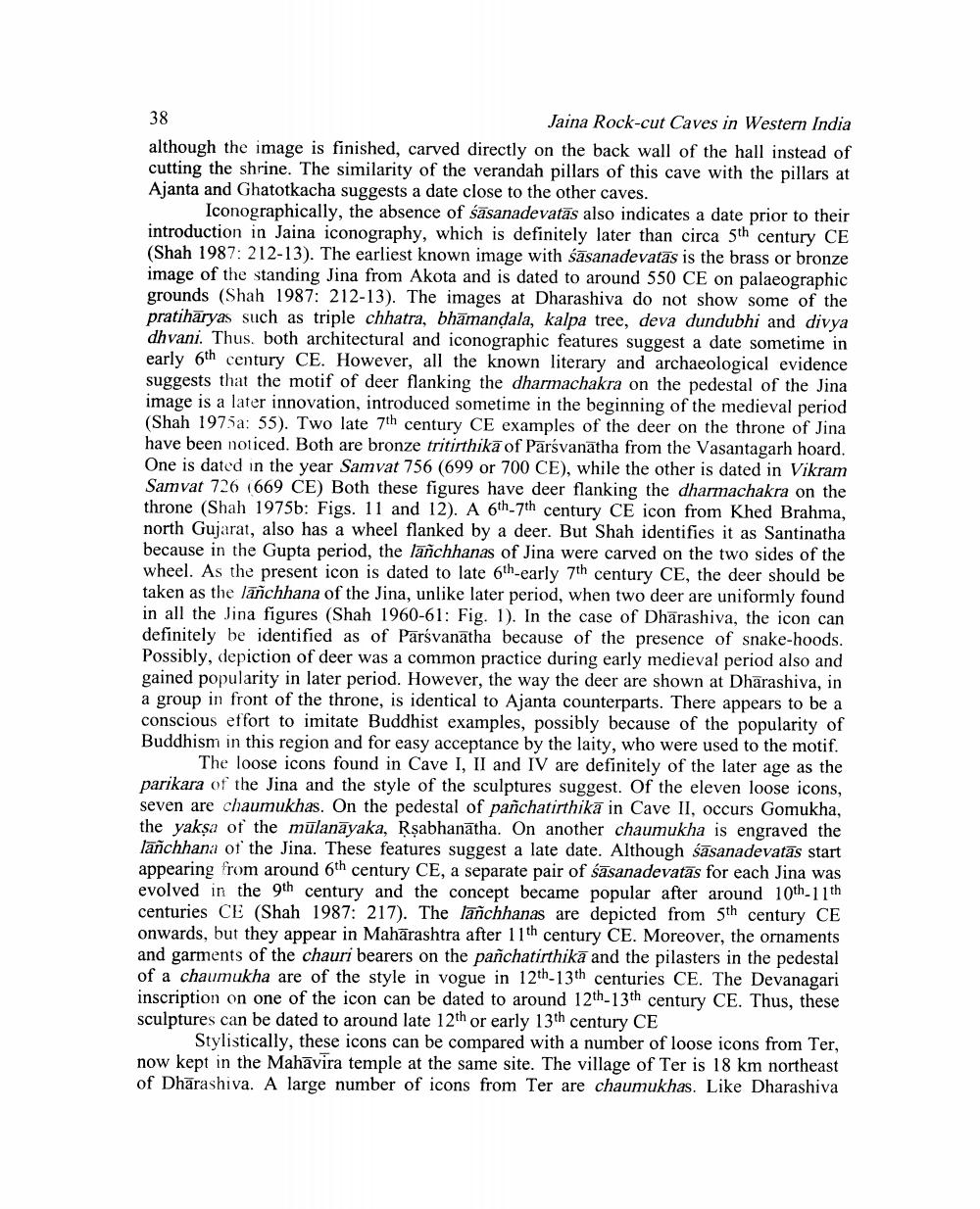________________
38
Jaina Rock-cut Caves in Western India although the image is finished, carved directly on the back wall of the hall instead of cutting the shrine. The similarity of the verandah pillars of this cave with the pillars at Ajanta and Ghatotkacha suggests a date close to the other caves.
Iconographically, the absence of śasanadevatās also indicates a date prior to their introduction in Jaina iconography, which is definitely later than circa 5th century CE (Shah 1987: 212-13). The earliest known image with śāsanadevatas is the brass or bronze image of the standing Jina from Akota and is dated to around 550 CE on palaeographic grounds (Shah 1987: 212-13). The images at Dharashiva do not show some of the pratihāryas such as triple chhatra, bhāmandala, kalpa tree, deva dundubhi and divya dhvani. Thus, both architectural and iconographic features suggest a date sometime in early 6th century CE. However, all the known literary and archaeological evidence suggests that the motif of deer flanking the dharmachakra on the pedestal of the Jina image is a later innovation, introduced sometime in the beginning of the medieval period (Shah 1975a: 55). Two late 7th century CE examples of the deer on the throne of Jina have been noticed. Both are bronze tritirthikā of Parsvanatha from the Vasantagarh hoard. One is dated in the year Samvat 756 (699 or 700 CE), while the other is dated in Vikram Samvat 726 (669 CE) Both these figures have deer flanking the dharmachakra on the throne (Shah 1975b: Figs. 11 and 12). A 6th-7th century CE icon from Khed Brahma, north Gujarat, also has a wheel flanked by a deer. But Shah identifies it as Santinatha because in the Gupta period, the lañchhanas of Jina were carved on the two sides of the wheel. As the present icon is dated to late 6th-early 7th century CE, the deer should be taken as the lañchhana of the Jina, unlike later period, when two deer are uniformly found in all the Jina figures (Shah 1960-61: Fig. 1). In the case of Dhārashiva, the icon can definitely be identified as of Parsvanatha because of the presence of snake-hoods. Possibly, depiction of deer was a common practice during early medieval period also and gained popularity in later period. However, the way the deer are shown at Dhārashiva, in a group in front of the throne, is identical to Ajanta counterparts. There appears to be a conscious effort to imitate Buddhist examples, possibly because of the popularity of Buddhism in this region and for easy acceptance by the laity, who were used to the motif.
The loose icons found in Cave I, II and IV are definitely of the later age as the parikara of the Jina and the style of the sculptures suggest. Of the eleven loose icons, seven are chaumukhas. On the pedestal of pañchatirthikā in Cave II, occurs Gomukha, the yakṣa of the mūlanāyaka, Rşabhanātha. On another chaumukha is engraved the lañchhana ot' the Jina. These features suggest a late date. Although śasanadevatas start appearing from around 6th century CE, a separate pair of śāsanadevatās for each Jina was evolved in the 9th century and the concept became popular after around 10th-11th centuries CE (Shah 1987: 217). The lanchhanas are depicted from 5th century CE onwards, but they appear in Mahārashtra after 11th century CE. Moreover, the ornaments and garments of the chauri bearers on the pañchatirthikā and the pilasters in the pedestal of a chaumukha are of the style in vogue in 12th-13th centuries CE. The Devanagari inscription on one of the icon can be dated to around 12th-13th century CE. Thus, these sculptures can be dated to around late 12th or early 13th century CE
Stylistically, these icons can be compared with a number of loose icons from Ter, now kept in the Mahavira temple at the same site. The village of Ter is 18 km northeast of Dhārashiva. A large number of icons from Ter are chaumukhas. Like Dharashiva




